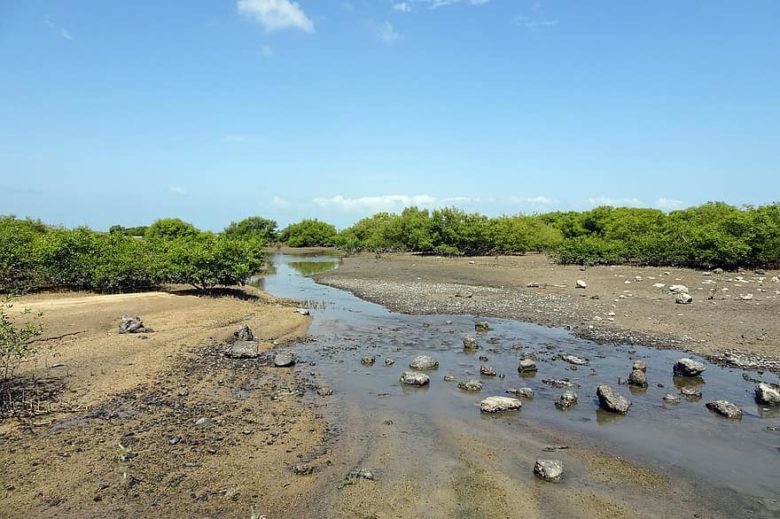
Where Camels Swim: Tale of Kachchh Mangroves
-
Coastal wetland conservation
Mangroves, for a majority of Indians, are synonymous with Sundarbans; the largest mangrove forest in the world situated within Ganga -Brahmaputra delta, on the east coast of the country. However, hidden from the public eye, there lies a mangrove marvel, diametrically opposite to Sundarbans, in desert district of Kachchh, abutting Arabian sea in the state of Gujarat.
Spread across 778 sq. kms, this mangrove belt on the west coast of the country, dominated by Avicennia marina is known for an indigenous breed of camels, locally known as Kharai, which swims in the shallow, saline coastal waters. Kharai camels, also known as Dariyataru, are ecotonal species having unique ability to survive both on arid land and in salty marine waters, making them an apt epithet for survival.
Kharai camels are mostly reared by nomadic pastoralist communities of Jaths and Rabaris and forms a major source of their livelihood. The dry conditions of the land doesn’t support rich vegetation, making mangroves, only major source of fodder for the camels, who swim across the waters to reach vegetation patches, growing on small islands. These camels, it is locally believed, prune the mangroves, allowing regenerated growth and their stamping embed seeds deep within mudflats helping them grow. Although, mangrove growth is slow due to difficult climatic conditions, the mature forest ecosystem supports a rich biodiversity of fish and a number of marine species, making fishing, a mainstay of economy in these parched lands. Kachchh mangroves, therefore forms an indispensable ecosystem both for the camels as well as human populace.

However, in spite of the critical nature, this mangrove habitat is under constant threat from expanding anthropogenic activities, pushing already endangered population of Kharai camels to the brink of extinction. The region has a special economic zone (SEZ) with several industries, Deendayal port trust, a thermal power plant and salt manufacturing units that are reported to clear mangroves for fulfilling their infrastructure requirements. Besides, formation of SEZ has also led to fragmentation and degradation of these wetland habitats. There have been reports of blocking of inlets from creeks by these industries, leading to gradual dying of the mangroves, making them easier to be uprooted.
With their habitat getting degraded, Kharai camels are also facing the heat and their numbers are constantly dwindling. As per reports, only around 1800 individuals of the species were left in Kachchh region in 2018, which is a matter of critical concern, having repercussions both for the species, as well as herder communities dependent on it.
Over the last few years, protests by the camel herding communities supported by environmental activists have led to some solace with National Green Tribunal taking cognizance of the matter and ordering Deendayal port trust to remove all obstructions and ensure free flow of estuarine waters to sustain mangroves in Nani Chirai and Moti Chirai region of Bhachau taluka located in Kachchh district. It was also ruled that environmental compensation must be levied on those responsible for destroying 750 acres of mangroves in the region.
Also, there has been a spurt in both government and corporate funded mangrove restoration activities. Although some of these follow community-based programs, yet lack of ownership and long-term involvement can act as impediments in regeneration of lost mangrove belts. Also, it is to be considered that plantations can never replace natural forests and have their own set of limitations. With slow growth of plantations and constant degradation of existing mangroves, we can soon be faced with the dilemma of saving the indigenous Kharai camels along with a number of marine species, dependent on these wetland ecosystems.
Conservation and restoration of Kuchchh mangroves is not just a matter of saving a species. Mangrove ecosystems are also natural defence systems that save the coastal communities from storm surges. Besides, these wetlands are also known for their carbon sequestration activities, storing more carbon than any other forest types, making them extremely pivotal for checking global warming.
It is high time that the governments and other stakeholders start considering critical mangrove ecosystems as irreplaceable natural assets. The myopic vision of replacing natural forests by corporate sponsored “compensatory” plantations, in lieu of unrestricted industrial development can do irreversible damage, gradually leading to extinction of dependent species and having implications for communities and traditions.
The case of dwindling populations of Kharai camels, therefore, is not just about saving another species. They symbolically represent thousands of wetland dependent species whose very survival rests on conservation of their intrinsic wetland habitats. They also are synonymous with a traditional system of harmonious living with nature, even in most extreme places, less conducive for habitation.
On this International day for the conservation of the mangrove ecosystem, Wetlands International South Asia urges respective governments, corporates, communities and other stakeholders to introspect and consider approaches for conservation of mangrove ecosystems, not just for the sake of survival of our swimming camels but for survival of a tradition, an indigenous way of life, ensuring human survival, even amidst climate change, in most extreme of conditions. The responsibility of conserving these assets lies with us and we must act fast!
